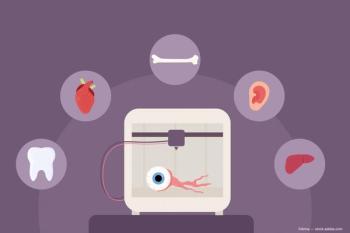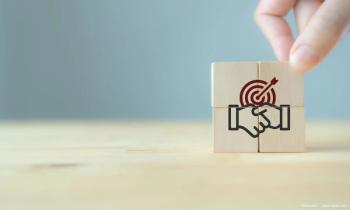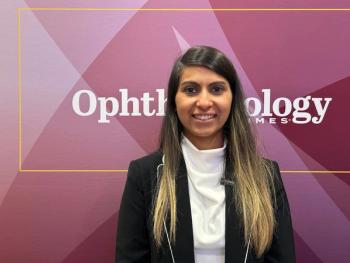
- Ophthalmology Times: June 15, 2020
- Volume 45
- Issue 10
Eyelid reconstruction: Urinary bladder matrix offers new xenograft for patients with large, difficult-to-treat lesions
Urinary bladder matrix, a skin substitute material made from porcine bladder, can be used successfully in periorbital reconstructive procedures.
This article was reviewed by Mark A. Alford, MD, FACS
Urinary bladder matrix is a skin substitute material derived from porcine (pig) bladder used extensively in general surgery and to treat burns.
The use of this product has now been extended to include periorbital reconstruction and is an effective alternative to granulation, skin grafts, or flaps in selected patients, according to Mark A. Alford, MD, FACS, an oculoplastic surgeon with North Texas Ophthalmic Plastic Surgery, Privia Medical Group, in Fort Worth.
“Our skin’s dermal extracellular matrix is a complex meshwork of proteins and carbohydrates, the main protein being collagen,” he said. “Collagen is supported by glycosaminoglycans and is woven together with proteoglycans and attached to cells with integrin and fibronectin.”
Alford explained these dermal components provide strength and structure to the skin and allow healing to take place.
How it works
The product (Cytal Wound Matrix and Micromatrix, Acell Inc) provides a source of naturally occurring growth factors, multiple types of collagen, laminin, fibronectin, proteoglycans, and elastin.
“Theoretically, the product acts as a bioscaffold that maintains and supports healing by facilitating remodeling of site-appropriate functional tissue to promote healing while preventing the development of scar tissue,” Alford said. “Studies have shown that the material decreases dermal fibrosis.”
Matristem is a xenograft, a material derived from animal tissue. Other commercially available xenograft materials include Integra Bilayer Wound Matrix (Integra LifeSciences Corp) produced from bovine collagen, shark, and silicone; OASIS Wound Matrix (Healthpoint Ltd) from porcine jejunum; and Matriderm (MedSkin Solutions Dr Suwelack AG) from bovine ligaments.
In contrast, allografts, which are derived from human tissue, include products such as AlloDerm Regenerative Tissue Matrix (LifeCell) and Dermagraft (Organogenesis, Inc).
Periocular reconstruction experience with the Acell matrix
Alford’s initial experience included reconstructive procedures in 17 patients (11 women, 6 men), specifically, 14 with periocular Mohs defects, and 1 each with epidermolysis bullosa, cicatricial ectropion, and a skin graft donor site. The patients ranged in age from 36 to 84 years.
Alford described some illustrative cases. A 47-year-old patient had periocular epidermolysis bullosa refractory to conventional wound care over 2 years. Epidermolysis bullosa is characterized by a defect in laminin.
Alford chose to use the ACell product because laminin is 1 of the glycoproteins supplied. The lesions healed after application of the urinary bladder matrix.
Another case involved a 66-year-old patient with a large, superficial Mohs defect of the brow. At 6 weeks postapplication, the skin was completely healed and eyebrow cilia were growing.
These patients showed significant improvement of their skin lesions. The ideal locations for use of ACell xenograft products are medial and lateral canthal defects, preauricular skin graft donor sites, and the superior rim and brow defects.
Further experience with the material has shown that defects in the central lower eyelid need additional procedures such as lid lightening. Eyelid margin defects have not been studied.
Standard application procedure
Alford now has experience with more than 40 patients and has standardized his application protocol. The material is available as Cytal Wound Matrix sheets of various sizes and thicknesses and as MicroMatrix powder.
First, the powder is moistened with a small amount of sterile erythromycin ointment and normal saline to create a workable paste.
After a sterile prep, the paste is used to cover or fill the defect and a 1-ply sheet of Cytal is sutured over the defect with a 6-0 chromic suture. The sheet is bolstered and patched for 2 weeks.
After bolster removal, antibiotic ointment is applied to the area daily for 2 more weeks. A light dressing such as a bandage is used for protection. The procedure requires about 10 to 15 minutes.
Alford reported that healing occurred with minimal scarring. No episodes of rejection, allergy, or infection have occurred.
“This is a quick and easy initial application, but close follow-up is required,” he said. “Even after 2 weeks of the bolster and patch, the defect looks ‘raw’ and patients need to be reassured. Most patients had some mild complaints about the long-term dressing.”
The retail cost of a 100-mg vial of powder is approximately $360 and a 3 x 3-cm 1-ply Cytal sheet is $86. The coding for the procedure is CPT 15275 (application of xenograft, eyelid) with a reimbursement of $150. Xenograft application is not bundled with other eyelid codes and can be used with other procedures.
“This product is fast, easy to use, and relatively inexpensive,” Alford concluded. “The procedure can be easily done in an office setting with local anesthesia and no sedation.”
Mark A. Alford, MD, FACS e: [email protected]
Dr Alford has no financial disclosures related to this content.
Articles in this issue
over 5 years ago
Hieroglyphics eyechartover 5 years ago
Minimally invasive glaucoma shunt delivers for patientsover 5 years ago
Study targets ocular damage from chronic intravitreal injectionsNewsletter
Don’t miss out—get Ophthalmology Times updates on the latest clinical advancements and expert interviews, straight to your inbox.













































.png)


